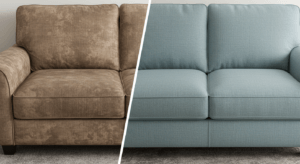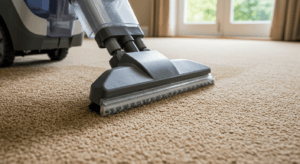Maintaining a clean living space extends beyond routine dusting and tidying, with carpets and rugs playing a pivotal role often overlooked. As filters, they trap dirt, dust, and allergens, enhancing aesthetics while impacting indoor air quality. This guide delves into factors shaping carpet cleanliness and offers expert advice on optimal cleaning frequency for a healthy and beautiful home.
Understanding the Importance of Carpet and Rug Cleaning
Regular cleaning of carpets and rugs is crucial as they harbor dust mites, allergens, and bacteria, impacting indoor air quality. Routine maintenance enhances carpet longevity and reduces health risks for allergy and respiratory sufferers. Homeowners can ensure a healthier living environment and reduce replacement costs by eliminating contaminants through proper cleaning.
Factors Influencing Cleaning Frequency
Determining the right cleaning frequency is vital for upholding cleanliness and hygiene across different settings. Foot traffic, surface type, and contaminant levels dictate cleaning needs. Customizing cleaning schedules ensures healthy indoor environments.
Foot Traffic: Foot traffic heavily influences cleaning frequency as it directly impacts the accumulation of dirt, debris, and germs in a space. High-traffic areas like retail stores or busy offices soil quickly, necessitating regular rug cleaning to maintain hygiene standards. Neglecting to adjust cleaning schedules based on foot traffic can accelerate surface wear, worsen air quality, and increase illness transmission risks.
Presence of Pets: Pet owners face challenges with pet hair, dander, and accidents on carpets and rugs. Regular cleaning is essential to combat these issues and maintain cleanliness and hygiene. Pets shed fur and create messes, requiring more frequent cleaning to prevent odor buildup and bacterial growth. Pet owners prioritize cleanliness for human and animal well-being, recognizing the importance of a clean environment for all occupants.
Allergies and Health Conditions: Regular carpet cleaning significantly enhances indoor air quality and minimizes allergens, especially for individuals with respiratory conditions or allergies. Maintaining a thorough cleaning routine is crucial to reduce allergen exposure for allergy sufferers prone to dust mites, pet dander, or pollen. Similarly, those with respiratory conditions like asthma require a clean environment to mitigate irritants and potential triggers. Mold and mildew, common allergens, thrive in damp areas, necessitating frequent cleaning, especially in moisture-prone spots. Additionally, individuals with weakened immune systems benefit from a clean environment to reduce infection risks, making regular carpet maintenance essential for overall well-being.
Spills and Stains: Immediate cleaning is essential to prevent stains from becoming ingrained and causing lasting harm to carpets and rugs. Spills and stains significantly impact cleaning frequency due to their potential to escalate into hygiene hazards and aesthetic concerns. Spills, especially in high-traffic or food-prone areas, attract pests and foster bacterial growth, posing health risks. Stains compromise surface aesthetics and become increasingly challenging to remove over time, emphasizing the importance of immediate attention to maintain cleanliness and hygiene.
Type of Carpet or Rug: The material and construction of your carpets and rugs significantly determine cleaning frequency. While some materials can withstand more frequent cleaning, others require gentler care to prevent damage. Synthetic fiber carpets may tolerate routine cleaning better than delicate natural fibers like wool or silk, which need gentler treatment. High-traffic areas and spaces prone to spills and stains require more frequent cleaning to uphold hygiene and aesthetics. Additionally, factors such as humidity levels, pet presence, and indoor air quality influence cleaning frequency by affecting the buildup of dust, dirt, and allergens within the carpet fibers.
Read More: Way to Clean a Very Dirty Carpet
Recommended Cleaning Frequency
Understanding the optimal frequency for cleaning various items and spaces is essential for maintaining cleanliness and hygiene standards. The recommended cleaning frequency ensures that surfaces, equipment, and environments remain free from dirt, germs, and contaminants, promoting a healthy and safe environment for occupants. By adhering to these guidelines, individuals can effectively manage cleaning routines and uphold cleanliness standards in residential and commercial settings.
Routine Vacuuming: To maintain cleanliness and prevent the buildup of dirt and debris, vacuum your carpets at least once a week, focusing on high-traffic areas and corners.
Professional Cleaning: Experts recommend scheduling professional carpet cleaning every 12 to 18 months for most households. However, families with pets, children, or allergy sufferers may benefit from more frequent cleaning, typically every 6 to 12 months.
Spot Cleaning: Address spills and stains promptly to prevent them from becoming permanent. Employ a gentle detergent or a specialized carpet cleaner, and delicately blot the affected region to avoid spreading the stain.
Are You Tired Of Staring At Stained And Dull Carpets, Wondering How Often You Should Clean Them?
Regular carpet and rug cleaning are crucial for a clean and healthy home environment. Considering factors affecting cleaning frequency and following expert advice, you can keep your carpets and rugs fresh, vibrant, and free from harmful contaminants. Invest in routine maintenance and professional cleaning to preserve their beauty and longevity while safeguarding your family’s well-being.
Ready for a cleaner, healthier living space? Contact 5 Star Carpet Cleaning for top-notch carpet cleaning services now!
















